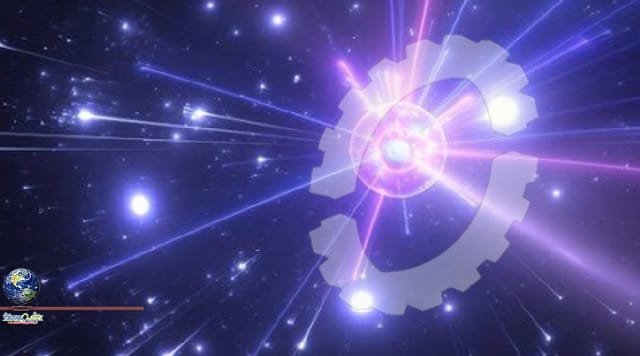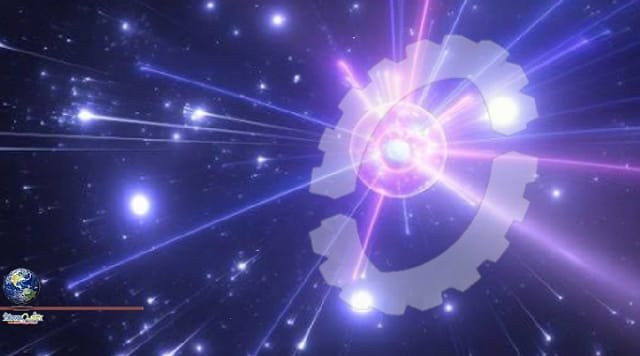Supercomputers to Solve High Energy the University of Southampton are seeking answers to physics mysteries at the highest energies and shortest distances. The team is devising new methods and enhancing their code in order to exploit the huge potential of the forthcoming Intel-HPE Aurora exascale supercomputer.

Supercomputers are required because we are studying phenomena that involve quarks and gluons whose interactions require enormous computer resources to accurately predict results. Using the Aurora exascale supercomputer will allow us to do high energy physics research that isn’t possible on existing supercomputers. Our research focuses on rare processes that are sensitive to new phenomena, which can appear directly only in experiments performed at energies far higher than those accessible in present particle accelerators.”
The team is using early versions of the Intel Xe GPUs and anticipates a 50X processing speed-up in running calculations compared to those done on the ALCF Mira supercomputer. The team’s improved codes targeting Aurora make extensive use of the oneAPI multi-platform framework.
Physics research seeks to discover information about the fundamental elements of matter and the laws, which govern their interactions. There are important phenomena observed on a cosmic scale such as the dominance of matter over anti-matter and the observations that suggest the existence of dark matter and dark energy that hint at new particles and interactions not present in the Standard Model.
Central to the Standard Model are elementary particles called quarks and gluons that combine to form particles known as hadrons which include the protons and neutrons that make up the atomic nucleus. Quarks have properties such as mass, electrical charge, color charge and spin. There are six known types of quark named up, down, charm, strange, top, and bottom.
For every type of quark, an antiquark exists with the same properties as the quark but with the opposite sign (negative versus positive) for the electric and color charges. The four heavier types of quark can change into up and down quarks through a process called weak decay. Extensive experiments performed over the past 70 years revealed how these quarks combine to form hundreds of different types of stable and unstable particles. In the 1970’s, scientists discovered that the large array of different hadron particles were actually different combinations of these six different types of quarks. The forces causing the quarks to combine could be described by quantum chromo-dynamics (QCD) equations that describe the strong nuclear force. However, solving these QCD equations was impossible before the development of supercomputers.
The realistic solution of QCD equations is only possible on modern supercomputers. The approach using supercomputers is dramatically different from the usual approach to quantum problems at the atomic scale. Richard Feynman developed an approach that requires carefully generating samples or snapshots of the fluctuating fields that describe the forces between the quarks. These samples indicate points in a space of 5 billion dimensions and require powerful computers to run the simulations.
Lattice QCD, developed in the 1970s, replaces the space-time continuum by a regular grid or lattice of locations, each corresponding to a specific point in space at a specific time. Research accomplishments using these methods evolved with each new generation of supercomputers enabling exciting new results which were previously out of reach. The large step in computer power represented by the class of exascale computers such as Aurora will again propel lattice QCD research to a new level.
The study of fundamental questions in particle physics using lattice QCD is a large international effort actively pursued on the fastest supercomputers around the world. Christ states, “In preparing to use an important new supercomputer such as Aurora, our research groups work together as a single Aurora Early Science project so that what is learned can benefit everyone. Our project is one part of the effort to be ready to use Aurora as soon as it begins to operate.”
“The weak decays in which the heavier four quarks (top, bottom, charm, and strange) transform into the two lighter up and down quarks are caused by processes that happen at very high energies. This energy is approximately one hundred times higher than the energy stored in the mass of the proton or neutron—the constituents from which the atomic nucleus is built. These high energies can accurately be treated by a complementary method called QCD perturbation theory. Lattice QCD can be used to solve the low energy part of the problem while QCD perturbation theory can handle this high-energy part.”
“The charm quark is too heavy to treat accurately with lattice QCD but too light to allow QCD perturbation theory to be used. Fortunately, this is a problem that Aurora can solve. The underlying difficulty created by the large mass of the charm quark is caused by its small quantum size. As a particle becomes more massive, its properties become more sensitive to what happens at shorter distances. If lattice QCD is to accurately describe the physics of charm quarks, the artificial distance between the lattice points must be made smaller than that needed to treat the less massive up, down, and strange quarks. If the lattice points are to be placed closer together, far more points will be needed to fill a volume of an appropriate physical size. These issues make the problem much more difficult. Typically, if the spacing between lattice points is reduced by a factor of two, the computational time required to solve this new problem will by one hundred times greater. Thus, this entire class of questions can for the first time be effectively tackled with Aurora.”
Sketch of the quantum process in which a K0 meson transforms into its anti-particle. The wavy lines represent gluons, the red lines light up and down quarks and the green line indicates a strange quark. The yellow squares show Standard Model weak interactions in which a strange quark transforms into three light quarks. The underlying grid structure indicates the process as computed using lattice QCD. Courtesy of Dr. Christ, Columbia University.
A large component of lattice QCD research is devoted to developing powerful algorithms and highly efficient computer code. The change from supercomputers constructed of arrays of interconnected CPUs (central processing units) to arrays of interconnected clusters of GPUs (graphics processing units) created huge challenges and huge opportunities for those developing lattice QCD codes and algorithms. The software used for the team’s ESP project is based on the open-source Grid system, software targeting lattice QCD developed by Peter Boyle of Brookhaven and the University of Edinburgh and his collaborators.
Grid was developed to replace the low-level but high-performance assembly language code used in early lattice QCD calculations. Grid exploits the features of the C++11 language and the significant advances in compiler technology to achieve assembly-language performance even for highly parallel CPU architectures from a high-level language. In fact, the abstractions used in Grid can also provide platform portability. Grid code can now be compiled both for CPUs and GPUs giving high performance on both architectures.
Aurora is taking advantage of the oneAPI industry initiative that will free researchers from the proprietary CUDA software that is widely used on the Summit supercomputer. This provides for code development on a broad-based open standard allowing developers to program once and run on different hardware from different vendors. To do so, Aurora supports solve the SYCL C++ abstraction layer that is part of the oneAPI industry initiative. As described above, running on Aurora required generalizations of Grid since lattice QCD code must be able to compile on both CPU and GPU systems.
Christ states, “Perhaps the greatest difficulty for lattice QCD is caused by the substantial increase in GPU computing power which is not matched by the performance of the communications network that interconnects the Aurora nodes, which are themselves clusters of well-connected GPUs. Since lattice QCD must exchange data between these nodes, such an imbalance between the processing power of the nodes and the bandwidth of the data communication between the nodes can result in a ‘network-bound’ application in which the slower communications network limits solve the overall performance.” The Intel solution slated for Aurora includes two Next Generation Intel Xeon Scalable processors (codename Sapphire Rapids) paired with six Intel Xe GPUs offering significant computing power for the available network performance.
“A major goal of the team’s Early Science preparations is to overcome these network challenges Solveby exploiting the size and power of the individual nodes. To avert the QCD communication problem, the team is reorganizing the calculation. A larger fraction of the calculation is divided among the powerful nodes and carried out with no communication between the nodes, using only infrequent bursts of communication between the nodes. Fortunately, there are earlier domain-decomposed algorithms that have this character, and which are now being actively reconfigured for Aurora’s architecture,” states Christ. This work will also benefit QCD on future technologies expected to continue this trend.
modified like lattice QCD has done to adjust to this architectural change and achieve optimal performance.
The Aurora supercomputer will also use Intel’s Next Gen Xeon Scalable Processor plus High Bandwidth Memory (HBM). It offers solve 64GB of high-bandwidth memory configurable in three modes: HBM-only, Flat, and Cache. End users running on Aurora can determine the mode in which to run the workload. It is anticipated that applications and problems that can fit within the available 64GB of HBM can run in HBM-only mode without changes. Similarly for those applications requiring more than 64GB, cache mode can be utilized without changes. Flat memory mode offers users greater control over tuning for optimal performance if developers are willing and able to make some algorithmic changes.
“A major goal of the team’s Early Science preparations is to overcome these network challenges Solve by exploiting the size and power of the individual nodes. To avert the QCD communication problem, the team is reorganizing the calculation. A larger fraction of the calculation is divided among the powerful nodes and carried out with no communication between the nodes, using only infrequent bursts of communication between the nodes. Fortunately, there are earlier domain-decomposed algorithms that have this character, and which are now being actively reconfigured for Aurora’s architecture,” states Christ. This work will also benefit QCD on future technologies expected to continue this trend.
“Having the power of the exascale Aurora supercomputer will open new vistas for lattice QCD research. For those processes in which the charm quark plays a central role, we expect to Solve carry out calculations that were not previously possible, obtaining results with a level of precision and accuracy with the potential to reveal new particles and interactions not present in the Standard Model. The same physical laws determine the behavior of matter at the smallest and largest scales. We may dream that these discoveries will also help to explain unanswered questions raised by the large-scale structure of the Universe such as nature of dark matter, dark energy, and the preponderance of matter over anti-matter, a dominance necessary for our existence,” says Christ.
Source :This news is originally published by hpcwire
